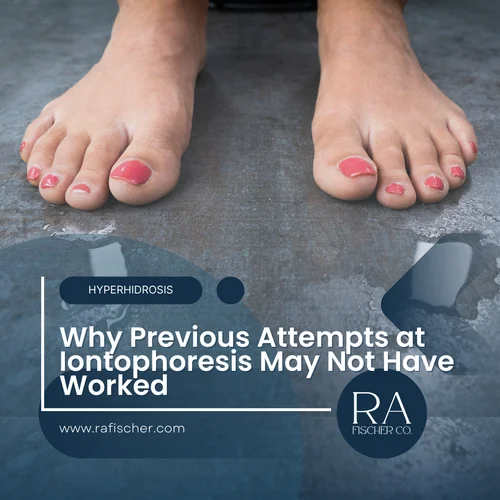September 25, 2023
No Comments
By
Daniel Moyer
Why Previous Attempts at Iontophoresis May Not Have Worked
Iontophoresis is a proven treatment for hyperhidrosis, using mild electrical currents to deliver minerals from tap water into sweat glands, creating a natural barrier to reduce perspiration. However, not all patients experience success on their first try.
If you’ve found previous iontophoresis attempts ineffective, it may be due to factors like soft water, using the wrong current type, or not following the correct treatment schedule. Let’s explore these common issues and how you can overcome them.
If you’ve found previous iontophoresis attempts ineffective, it may be due to factors like soft water, using the wrong current type, or not following the correct treatment schedule. Let’s explore these common issues and how you can overcome them.
Why Iontophoresis May Not Have Worked
1. Soft Water: The Missing Minerals
Why It Matters
Iontophoresis relies on the natural minerals in tap water—such as calcium, magnesium, and potassium—to "plug" sweat glands and create dryness. However, if your home uses a water-softening system or your area has naturally soft well water, these essential minerals may be filtered out.
How to Fix It
If soft water was the issue, try one of these solutions:
- Add baking soda: A small amount of baking soda can restore the water’s conductivity.
- Use an external water source: Tap into an outdoor faucet or hose for untreated water.
- Buy mineral water: Store-bought mineral water ensures proper ion delivery.

Why Iontophoresis May Not Have Worked
2. Using the Wrong Current Type
Understanding Direct and Pulsed Current
Iontophoresis devices use either Direct Current (DC) or Pulsed Current (PC). Direct Current provides consistent ion delivery and faster results, making it the top choice for most patients. Pulsed Current, on the other hand, is gentler but less effective because it delivers ions intermittently.
Why It Matters
A device like The Fischer offers both Direct and Pulsed Current settings, allowing you to:
- Use Direct Current for faster, more effective treatments.
- Switch to Pulsed Current for increased comfort if sensitivity is an issue.
Why Iontophoresis May Not Have Worked
3. Not Treating Long Enough
Why Treatment Duration Matters
Iontophoresis requires consistency and a structured schedule to achieve results. Initially, you may need 20-minute sessions every other day for two weeks. Gradually, as sweating decreases, you can reduce treatments to 1–2 times per week.
Patients who stop too soon or skip sessions risk seeing little to no improvement.
Patients who stop too soon or skip sessions risk seeing little to no improvement.
How to Fix It
Follow a structured plan:
- Start with 20-minute sessions per area every other day for two weeks.
- Transition to maintenance mode as sweating decreases, treating less frequently.
- Consult a specialist: An RA Fischer Treatment Specialist can guide you through adjustments based on your symptoms.
"Talk to our Treatment Specialists today to see why the Fischer iontophoresis device is the best treatment available for hyperhidrosis and to check insurance benefits."
Jennifer Jacobellis - CEO
Why Choose The Fischer Iontophoresis Device?
The Fischer device addresses the common issues that may have hindered your previous treatments.
Don’t let past challenges keep you from dryness. Explore The Fischer today and take control of your hyperhidrosis journey!
Don’t let past challenges keep you from dryness. Explore The Fischer today and take control of your hyperhidrosis journey!

Leave a Reply Cancel reply
You must be logged in to post a comment.
